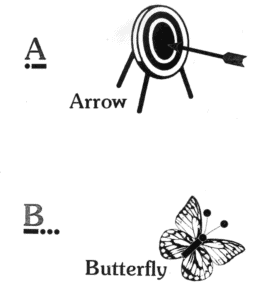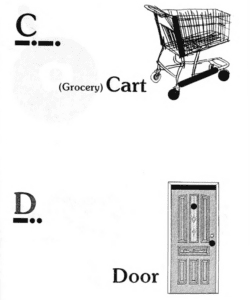Jim Lubin: An Interview
When Jim Lubin was 21 years old, he had a severe attack of TM that rendered him quadriplegic, paralyzed from the neck down, and dependent on a ventilator to breathe. He made the very best out of a difficult situation and relearned how to use computers through the utilization of adaptive technologies.
Most notably, he utilized the Sip & Puff method of inputting morse code, which can communicate letters to the computer through the use of a mouth tube rather than through a keyboard or mouse. When he “sips” the tube, the computer understands it as a morse code dot, and when he “puffs” the tube, the computer understands it as a morse code dash. Although the system may to an outsider seem daunting, Lubin writes in detail about the process in his article, Morse Codes for Computer Access. He states that “its most important advantage is its ability to become a sub-cognitive process. After using the code for a period of time, the Morse code user no longer thinks about the code they’re entering. This is the same process as is used by touch typists and it has a significant impact on speed, accuracy and the quality of the work being produced. Morse code is the only alternate access method that can become a sub-cognitive process.”
Recently, he contacted an adaptive technology company called ATMakers to create a new Morse code device to access a computer just in case the one he’d been using for 30 years, called the Adap2U, ever stopped working since the company which made it closed 20 years ago. This was a very wise choice, because as of a few weeks ago, it stopped working.
If there hadn’t been a backup plan in place, Jim would no longer have had access to a computer. In gratitude, he wrote a letter to ATMakers, specifically regarding Bill Binko, the technician who had helped him set everything up ahead of time. Once Bill worked on his set up, Jim states that “it worked for me to enter any keyboard key, move the mouse, and click the mouse buttons using sip and puff with no head movement. There were a few features that I used on the Adap2U that hadn’t been implemented yet, but I was excited to have a working backup way to use the computer. After my Adap2U stopped working, we plugged Bill’s device into my laptop USB, and I returned to using my computer within minutes!” The new device was made with parts anyone can purchase and build. Bill made his program open source and freely available for anyone to use and modify for their use.
We conducted two interviews with Jim recently. The following will be a written transcript of those interviews:
Q: What did being taught the sip & puff method of using a computer feel like? Were there any pitfalls along the way and moments of doubt that you could learn that system? When did it finally click that “hey, maybe I can do this?”
A: I started learning the codes when I was still in ICU with the speech therapist. She had a sheet with images with the codes. I had the chart on the ceiling above my bed. I started memorizing the icons. When I went to rehab and had access to a computer I got to practice using the air tube connected to the sip and puff switch. I operated my electric wheelchair with sip and puff as well.
Q: How has having access to the internet improved your quality of life?
A: Well, back then there were online services not connected to the internet. Everything was text with no mouse. I used chat rooms and message boards to meet other people. I was also working on writing a program for the company I worked at. My job did not involve programming, I taught myself how to program in Microsoft QuickBASIC to be able to write the program they needed. The company compensated me with computer equipment that I wanted. That is how I spent most of my time back then. When the internet became more mainstream, I started making websites and email listgroups.
Q: Are there any technologies on the rise that you think would further improve your ability to access computers? Speech-to-text, eye-movement tracking, etc? Would this be something you’d personally consider, or are you partial to the sip & puff?
A: Most of what I do on the computer can be done using the mouse. Speech-to-text has improved, but since I am usually watching something on tv, with the sip & puff I can still keep typing. With eye tracking you need to be in front of the tracker lens, I usually have my computer off to the side, so my laptop screen is to the edge of the TV screen that way I can see both screens. The Neuralink brain-computer interface looks pretty neat!
Q: Do you feel safer knowing you now have a new method to input morse code, despite Adap2U becoming incompatible? What were you feeling like before you had the safety net in place?
A: It is reassuring to have another method to access the computer. I have tried just about every other method that has become available for adaptive computer access, but none worked as well for me given my abilities.
Q: And I know this is a stupid question, but what do you like to do online? What TV shows do you like to watch? What are your things, your favorite things to do online?
A: I have been doing some genealogy research with a few of my cousins. I enjoy sci-fi shows. For All Mankind, Fallout, 3 Body Problem to name a few. I work on a few websites, but not as many recently. I also help with SRNA IT stuff when I’m needed.
Q: That’s cool! You’re pretty good for IT, which is awesome. I read in one article that was released in 2008 that when someone would email you, you’d email back in fifteen minutes with the problem solved.
A: Yeah, yeah, Sandy said that. At the time, we were all volunteers for the TMA, and I was on the computer all day, so I’d respond right away.
Q: Yeah, that article is nice. It depicts your spirit really well—the way you approached it with such a good mindset.
A: A psychiatrist at one of the symposiums, he uses me as an example for folks who want to learn to live with their situation. A lot of folks on message boards, they’re saying they are waiting for a cure to happen. I just accept it and my situation.
Q: I think that’s a wonderful way of seeing it. I understand not hoping for a cure. I personally have been in the same spot with my NMOSD, but not to this same extent. I wrestled with it, and eventually said “if I do die, I do die, but I need to make sure I’m living to the maximum capacity I can, even if I can’t walk for long distances, even if someday it’ll come back, if my NMO relapses again and again the way it used to, I won’t regret living.” I stopped hoping for a cure so that I’d stop putting my life on hold until someday it does—because the answer to “when will I get better” is not one that I can answer. What’s your ideology in regards to that? Live life the best you can at the level that you can?
A: I was never waiting for a cure—I got sick, there’s nothing I did, there’s nothing I could do to stop it. I moved on with my life, I asked “What am I able to do?”
Q: I’ve read a lot of your articles, and what Sandy wrote about you. You approached it really well, especially considering you were only 21 when it happened. You kinda just went for it? You kinda just went, “I’m going to manage this the best that I can?”
A: I wasn’t into sports. I was interested in and using computers before most people even had personal computers. The only way I was going to get back on the computer was to learn morse code, at that point. I was still able to do the things I enjoy doing.
Q: You’ve worked for years on the digital aspects of the TMA, now SRNA. You’ve gathered a tremendous amount of information and developed and moderated several message boards and forums. You’ve been the bones of this entire organization. If it’s not hope for a cure that’s driving you, what does?
A: I just enjoy helping people. When I first set up my disability website, I just went and looked for information and collected it. And when people would reach out to me, even if they didn’t have TM, I’d look for a solution. I’d get thank you cards from people, like a guy who needed a prosthetic ear and I found a maker for him. There was a need for disability resources to be translated, so I found a translator. There was a need for support groups in other countries, I helped sort that out.
It’s a very inspiring interview. To have made the best of what is an incredibly difficult circumstance, and to dedicate one’s life to helping others despite it all is an amazing and honor-worthy choice.
So, SRNA chose to honor him. For those of you who are not aware, in 2008, SRNA chose to start the James T. Lubin Clinician-Scientist Fellowship award to support the post-residency training of clinicians and scientists committed to careers in academic medicine specializing in rare neuro-immune disorders of the Central Nervous System. (Lubin myelife. my hope)
There is no greater need in our community than the provision of medical care by neurologists who have experience and expertise in these rare disorders. There is also a critical need to foster the development of scientists who are interested in these disorders. What better way to recognize and honor Jim than to establish a fellowship that will ultimately provide the best clinical care to the people Jim has devoted his life to helping and find the causes and cures for rare neuroimmune disorders?
As SRNA’s president Sandy Siegel once wrote, “The James Timothy Lubin Fellowship emanates from our admiration and respect for Jim and our gratitude for all he has accomplished for all of us. Thank you for inspiring the best from each of us, Jim. We love you.”
Although those who’ve been here for the long-haul may have known of Jim before, there are those who do not, and that’s a shame. Jim is what this organization stands upon, what it protects, and one of many who it represents.
Articles represent the views of the author and do not necessarily represent the views of SRNA.




